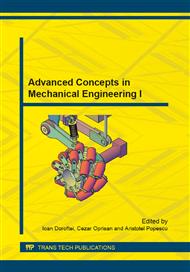p.501
p.507
p.513
p.520
p.526
p.535
p.541
p.547
p.553
Stresses and Displacements for Virtual Models of Healthy and Osteoarthritic Knee Joint
Abstract:
This paper presents advanced modeling and simulation methods, using the latest generation of CAD-CAE applications. For the geometric modeling of human knee joint embedded applications as DesignModeler, SpaceClaim under Ansys Workbench software package were used. The objective of this study is to present our contributions on the modeling, simulations and finite element analysis of the healthy and osteoarthritic human knee joint in order to quantify and investigate its biomechanical behavior. The main objective of this article is to present a complex three-dimensional model of the healthy knee joint and of the osteoarthritic joint which shows a 15o tilt in varus, the joint being affected by osteoarthritis in both compartments, in order to predict stresses and displacements in their individual components. The applied forces were equal with 800 N and 1500 N. Finally the results obtained for normal knee and for OA knee joint are compared.
Info:
Periodical:
Pages:
526-531
Citation:
Online since:
October 2014
Authors:
Price:
Сopyright:
© 2014 Trans Tech Publications Ltd. All Rights Reserved
Share:
Citation:


